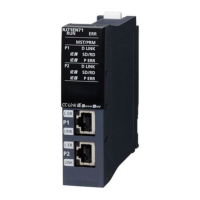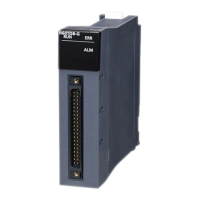440
31 POSITIONING INSTRUCTION
31.3 Mechanical OPR
Caution
• Detection of (the rear end and the front end of) the near-point dog will be affected by the input response time and the scan
time of the sequence program. Secure 1 scan time or more from the rear end of the near-point dog to turning ON of the
zero signal.
• Since the zero signal of the servo motor is used, adjust the relation between the rear end of the near-point dog and the zero
signal as shown in the following figure. If fine adjustment of the origin position is needed, adjust the position of the near-
point dog.
• Properly set the near-point dog so that the near-point dog can be kept at the ON status until the speed is reduced to the
creep speed. Deceleration to the creep speed starts at the front end of the near-point dog, the operation stops at "the rear
end of the near-point dog" or at "detection of the first zero signal after the rear end of the near-point dog", and the current
address is cleared. If the speed is not reduced to the creep speed before detecting the rear end of the near-point dog, the
operation may not be stopped at the specified position.
• Use the near-point dog between the reverse rotation limit 1 (LSR) and the forward rotation limit 1 (LSF). The intended
operation may not be performed if the relationship among the near-point dog, reverse rotation limit 1 (LSR), and forward
rotation limit 1 (LSF) is not as shown in the figure below.
• The creep speed should be sufficiently slow. Deceleration stop is not performed. For this reason, if the creep speed is not
slow enough, the operation may not be stopped at the specified position due to inertia.
• When using the high-speed pulse input/output module with OPR zero signal counts set to 0, the position of the origin
position varies under influence of the calculation period. If an operation to stop immediately after the detection of the dog
signal is made, executing OPR with the following setting reduces the variance of the origin position. However, it is
necessary to adjust the length of the near-point dog signal so that the time of OFF to ON of the near-point dog signal is one
scan or longer.
• If the dog search function cannot detect the near-point dog signal, the speed will decelerate and the operation will stop. The
execution of the instruction ends with an error.
• In the case of the high-speed pulse input/output module, if the CJ instruction is used to skip the DSZR/DDSZR instruction,
the near-point dog signals become undetectable. (Page 556 When a user interrupt is used) If the instruction is skipped,
the operation to detect the forward limit or reverse limit and stop is made.
Positioning parameter (Zero Signal Device No.: X+5)
• Zero Signal Count Start Time: Near-point Dog Latter Part
• Zero Signal OPR Zero Signal Counts: 1
• Near-point Dog Signal Device No.: X+5 (same device as
zero signal)
• Near-point Dog Signal Logic: Negative Logic
Near-point DOG
Rear end Forward end
Operation direction
Zero signal
Longer than
1 scan time
LSR LSF
Reverse
rotation limit 2
(Servo amplifier side)
Reverse
rotation limit 1
(CPU module side)
Forward
rotation limit 1
(CPU module side)
Forward
rotation limit 2
(Servo amplifier side)
Servo motor
Reverse rotation Forward rotation
Near-point DOG
DOG signal
(Zero signal)
Creep speed
Near-point DOG
Time
OPR speed
Speed
1 scan time or more

